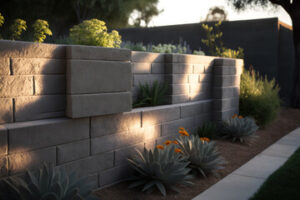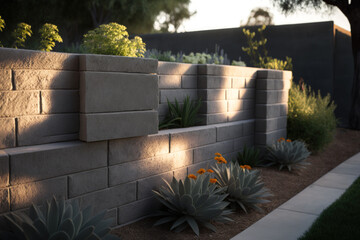Concrete retaining walls are a great solution for controlling erosion, eliminating hard-to-mow slopes, and adding garden space. They can be designed to look like stone and are often used in public spaces.
They are also highly durable, with a long lifespan. They can be constructed in a variety of styles and complement both traditional and contemporary landscapes. Hire experts from Concrete Contractors Colorado Springs for your concrete projects.

Durability
While poured concrete may seem like the obvious choice for your retaining wall, it’s not without its drawbacks. While it is stronger than blocks, it can be vulnerable to chemical damage and needs regular maintenance to keep its surface looking pristine. A poured concrete wall can also be quite pricey to construct, making it not the best option for those on a tight budget.
Concrete block walls, also known as cinder block walls, are much less expensive to build and can be used for many of the same purposes as poured concrete retaining walls. They can be customized to fit any landscaping design, and the blocks are sturdy enough to support a variety of soils. They can also be designed to look more finished than a poured wall with the use of a brick or stone veneer.
A retaining wall made from wood planks or timber can be a great way to accent your landscape, but it has a limited lifespan. Wood can rot, become a home for termites or weeds, and quickly become unsightly if it isn’t maintained properly. Concrete offers a long-lasting alternative to timber, and is a good choice for those looking for a low-maintenance material.
Concrete is also fireproof, and withstands freeze-thaw cycles that can be problematic for some other materials. Concrete is often chosen for retaining walls because of its ability to resist road salts and other chemicals commonly used on driveways and roadways.
Another benefit of concrete is that it’s easy to work with compared to other building materials. A retaining wall built with concrete blocks can be installed by a homeowner, while a poured wall must be constructed on-site and requires specialized tools.
The most common cause of retaining wall failure is when the soil is saturated in water, which puts constant pressure on the structure. Providing proper drainage and implementing permeable soils to prevent this can help alleviate this problem. Watch for signs of a retaining wall that’s in trouble, such as bulging, cracking, or leaning. Addressing these issues promptly can keep your retaining wall in good condition and avoid the costly repair or replacement costs that come with a failed structure.
Strength
Retaining walls are designed to keep soil in place, and they’re often used for landscaping purposes. They can be built to prevent soil erosion, create usable beds from steep terrain, and even provide decorative features. They can be freestanding or part of larger construction projects such as buildings or roads.
Concrete is an excellent material for retaining walls, as it offers incredible strength and durability. It’s also fireproof, rot-proof, and rust-proof. In addition, concrete is highly resistant to road salts and freeze-thaw cycles in harsh winter climates. Furthermore, it’s a good choice for retaining walls because it can be poured in different shapes and sizes. This versatility makes it easier to incorporate curves and angles into your design.
If you’re building a concrete block retaining wall, it’s important to plan for its strength. You’ll want to lay the first course of blocks level, left-to-right and front-to-back. To ensure this, you can use a carpenter’s level to check each block before it’s laid. You can also back-set each course by 3/4” to give the wall added strength and stability. This technique is especially useful for taller retaining walls, as it helps the wall resist lateral earth pressure.
For a stronger, longer-lasting concrete block retaining wall, you’ll want to build it with a reinforced concrete mix. Reinforced concrete consists of aggregates mixed with cement, which is then shaped into forms and tamped down. The reinforced concrete is stronger than plain concrete, and it can withstand large loads without failing. It’s also less expensive than poured concrete, and it’s easy to work with.
When building a concrete-block retaining wall, it’s important to keep the footings below the frost depth. It’s also important to place the footings on a bed of gravel, which helps reduce pressure and movement. Additionally, the footings should be large enough to allow for adequate paving or planting.
Another type of retaining wall is a piled retaining wall, which uses a series of piles to hold soil. This type of retaining wall can be constructed up to 6 meters high. It’s important to note that building regulations may be required for a retaining wall above 1 meter near a road or path or over 2 meters elsewhere.
Styles
There are a variety of styles to choose from when it comes to concrete retaining walls. Some are built of poured concrete, others use blocks that interlock and still others are made from bricks or stone. The best choice for your yard depends on the style you like and how you plan to use the wall. You also need to consider the cost of the different materials and how much maintenance they require.
A good retaining wall can protect your property, and it can also be used to create a dramatic landscape that will add value to your home. It can also prevent soil erosion and prevent the movement of the earth in front of your house. In addition, a retaining wall can save you money by protecting your home from property damage caused by flooding and sinkholes.
You can build a retaining wall with many different materials, but concrete is a good option for many applications because of its durability and low cost. It is also relatively easy to work with and can be shaped in various ways to complement the existing landscaping. These features make concrete retaining walls an attractive choice for residential and commercial landscaping projects.
To construct a concrete block retaining wall, start by building a base with a layer of crushed gravel or other fine material. Lay the first course of blocks on the base and check them with a carpenter’s level to ensure they are even from left to right and front to back. After the first course, you can begin adding additional layers. Once you’ve reached the desired height, you can install a cap block on top of the wall to finish it off.
Poured concrete walls are much stronger than block retaining walls and can be constructed at a higher height. However, they can crack or crumble if the soil is too wet. They are typically a better choice for large, commercial construction projects, but they can be costly for smaller jobs.
Wood retaining walls are another popular option for small landscape projects. They are made from easily accessible, renewable materials and can be shaped to fit most design styles. They can be constructed to a maximum of four feet in height, and they are often used in modern landscaping projects.
Cost
A retaining wall is designed to keep the earth from shifting and falling away from a building or yard. It also serves to correct the natural slope of a landscape, giving homeowners more usable space for gardening and enjoying their property. In the past, retaining walls were often constructed of stone and brick, but concrete is now proving to be one of the most suitable materials for this task. Concrete retaining walls are stylish, long-lasting, and durable. Moreover, they can be carved into shapes that blend in with the surrounding landscape to add to their aesthetic appeal.
The cost of a concrete retaining wall can vary depending on the materials used, the height of the structure, the location and accessibility of the site, and the need for reinforcement. For example, a concrete retaining wall made with precast blocks can range in price from $15 to $60 per square foot. A poured concrete retaining wall costs significantly more and requires more labor to construct.
Decorative finishes for the walls can increase the cost as well. A simple unfinished wall will be the cheapest but adding texture, color or a stucco finish can drive up costs for both the material and labor. If a retaining wall is needed to hold back significant amounts of soil it may require the expertise of a structural engineer, which will also add to the overall project cost.
Before a retaining wall can be built, the land must be cleared and leveled. This can cost anywhere from $500 to $3,000 and involves digging out and compacting the dirt around the area where the retaining wall is going to be built.
In addition to the excavation and construction of the retaining wall itself, you should also consider the cost of installing drainage systems. This can be done by burying pipes, digging weep holes in the wall, or using filter fabric. If a retaining wall is being built in an inaccessible location, it may be necessary to rent a crane for the job.
Finally, a retaining wall must be waterproofed correctly to prevent water from seeping into the soil and causing damage to the structure. This is a costly process, but it is vital to the longevity of the wall. In many cases, a retaining wall that is not properly waterproofed can collapse, creating serious hazards for anyone nearby.

